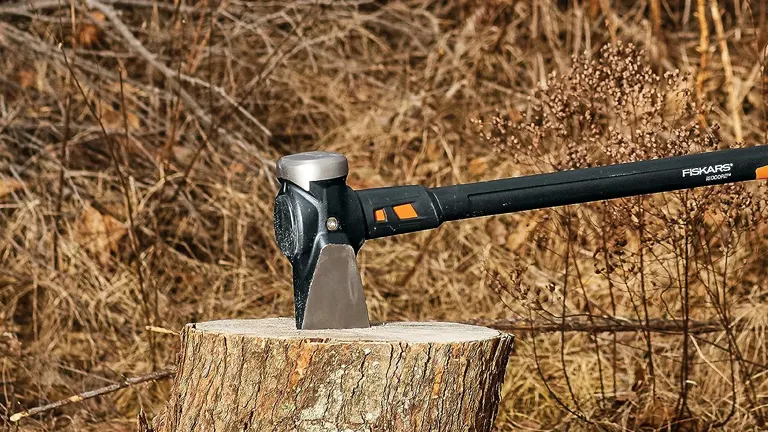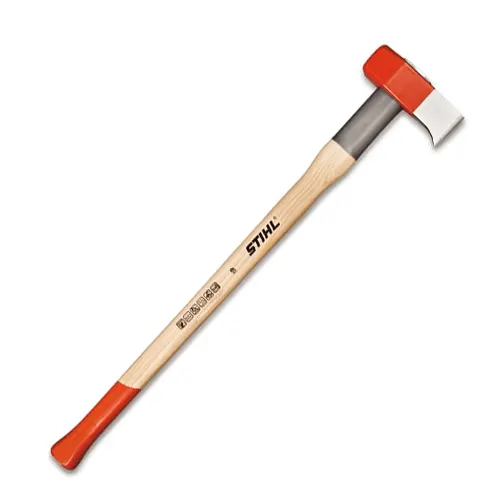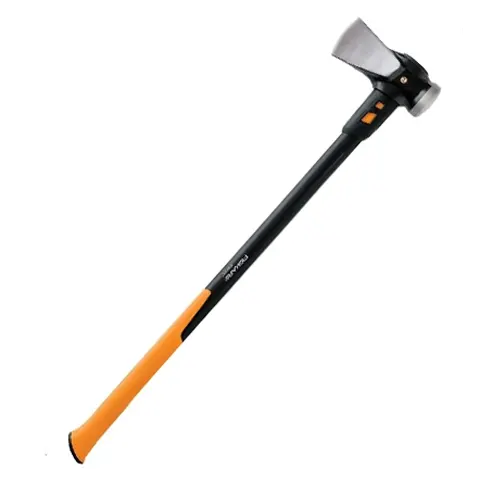Best Wood Splitting Mauls of 2025: Forestry Review
- May 11, 2023
- 0 comment
Welcome to 2025, a year where the timeless task of wood splitting meets modern innovation and craftsmanship! For both seasoned foresters and weekend woodsmen, finding the right tool is key to efficient and enjoyable work. This year’s lineup of wood splitting mauls brings together ergonomic designs, advanced materials, and a touch of sustainable ingenuity.

Our article is set to introduce you to the Top 10 mauls that have made a mark in the market. From handling the toughest logs to ensuring user comfort, these tools are at the forefront of forestry technology. Join us as we break down what makes each maul a must-have for your wood-splitting needs, combining expert opinions and user experiences to guide you through this year’s exceptional choices.
List of 10 Best Splitting Mauls:
- Fiskars IsoCore 8 lb Maul, 36 Inch
- Stihl Pro Splitting Maul
- Roughneck log Splitting Maul 2000g
- Gränsfors Bruk Splitting Maul
- Husqvarna 32″ Wooden Splitting Maul
- Truper 32415 12-Pound Splitting Maul
- Wilton Tools 8 lb. Head – 36″ B.A.S.H Splitting Maul
- Estwing Fireside Friend Axe – 14″ Wood Splitting Maul
- Helko Werk Vario 2000 Heavy Log Splitter
- Garrett Wade Professional Maul
Best Rated Wood Splitting Maul Top Picks
1. Fiskars IsoCore 8 lb Maul, 36 Inch
Specifications
- Weight of Cutting Head: 8 lbs
- Blade Material: Alloy Steel
- Overall Length: 36 inches
- Handle Material: IsoCore shock-absorbing material
- Color: Black
The Fiskars IsoCore 8 lb Maul, with its 36-inch handle, is tailored for users seeking a combination of power and leverage, especially beneficial for taller individuals. The design focuses on maximizing efficiency in splitting larger logs, with a well-balanced weight distribution and an advanced blade geometry that promotes one-strike splits. This makes it particularly effective for processing a large volume of wood. The IsoCore shock-absorbing handle is a noteworthy feature, designed to minimize hand strain and enhance control, which is invaluable during prolonged wood splitting sessions. However, users with a preference for lighter or more compact tools might find the size and weight of this maul less accommodating.

While the blade’s durability is commendable, maintaining sharpness longer than many traditional axes and facilitating efficient splitting, the tool’s overall effectiveness can vary depending on the user’s physical strength and splitting technique. The non-slip grip and ergonomic design are thoughtful additions, yet the maul’s dimensions and heft may not be universally appealing. The lifetime warranty is a strong indicator of Fiskars’ confidence in their product, making this maul a considerable option for those in need of a robust and durable tool for heavy-duty tasks, while also highlighting the importance of aligning the tool with individual needs and preferences.
Pros
Excellent shock absorption, balanced weight for power and control, durable, long handle for leverage, ideal for taller users.
Cons
Might be too heavy for some users, length may be cumbersome for shorter individuals or tight spaces.
2. Stihl Pro Splitting Maul

Specifications
- Weight of Cutting Head: 6.6 lbs
- Overall Length: 33.5 inches
- Handle Material: Hickory
- Color: Traditional wood finish
The Stihl Pro Splitting Maul is a robust and efficient tool, designed for those who take their wood splitting seriously. With a 6.6 lb cutting head and an overall length of 33.5 inches, it offers a blend of power and control, suitable for splitting large wood rounds and driving wedges. The maul’s head, crafted from premium C60 steel, features an extra-large striking face, significantly enhancing splitting performance. Each swing delivers a satisfying punch, making it effective for tough, demanding tasks. The maul’s unique 5-piece head attachment system, touted to be significantly stronger than traditional axe connections, adds to its durability and safety, ensuring a longer lifespan even under strenuous use.

The use of American hickory for the handle is another thoughtful aspect of the design. Hickory is renowned for its strength and ability to absorb shocks, which reduces vibrations felt during use, thereby minimizing user fatigue. The inclusion of a long steel sleeve to protect the handle from overstrike damage is a practical feature, though it does contribute additional weight to the maul’s head, potentially impacting swing dynamics. Users looking for a lighter maul may find this aspect less appealing. Overall, the Stihl Pro Splitting Maul is a well-considered tool, striking a balance between heavy-duty performance and user-centric design, making it a compelling choice for both professional and residential settings, particularly for those who don’t mind its heftier head.
Pros
Durable hickory handle, effective for splitting and driving wedges, hardened striking face, dual-purpose head.
Cons
Slightly heavier head could be tiring over long periods, and may not be ideal for smaller logs.
3. Roughneck Log Splitting Maul 2000g

Specifications
- Weight: 2.65 Kilograms (approx. 5.84 lbs)
- Product Dimensions: 70L x 20W centimeters (approx. 27.56L x 7.87W inches)
- Handle Material: Alloy Steel
- Color: Brown
The Roughneck Log Splitting Maul 2000g is a tool that appears to focus on balancing efficiency and durability. With a weight of approximately 2.65 kilograms and dimensions of 70L x 20W centimeters, it is designed for those who require a reliable maul for splitting logs. The key feature of this maul is its anti-jamming dual wedge head, made from polished steel with anti-rust protection. This design not only increases splitting efficiency but also aims to prevent the frustrating issue of jamming – a common problem in log splitting. Additionally, the drop-forged and heat-treated construction, coupled with induction-hardened striking faces, speaks to its extreme strength and durability, making it suitable for heavy and repeated use.

The handle of the Roughneck Maul is crafted from FSC Certified solid hickory, known for providing both strength and flexibility, which is vital in absorbing shocks during the splitting process. This choice of material for the handle is a nod towards both performance and environmental responsibility. However, the heft of the maul, along with its robust construction, might make it more suitable for users with a bit more strength or those accustomed to handling heavier tools. It’s also worth noting that the maul comes with a protective canvas sheath, a thoughtful addition for safe storage and maintaining the tool’s condition. This maul seems to be a practical choice for users seeking a durable, efficient, and eco-friendly option for regular log splitting tasks, though its weight and size may be a consideration for those looking for a lighter or more compact alternative.
Pros
Anti-jamming head, durable polished steel with rust protection, FSC certified hickory handle, induction-hardened striking faces.
Cons
Weight distribution might not suit all users, and shorter handle length may reduce leverage
4. Gränsfors Bruk Splitting Maul
Specifications
- Head Weight: 5 1/2 lbs
- Length with Handle: 31.5 inches
- Handle Material: Leather, Steel, Wood
- Color: Brown and Silver
The Gränsfors Bruk Splitting Maul is a standout tool, especially for those dealing with very thick and knotty wood chunks. Its design is a testament to Gränsfors Bruk’s reputation for quality and efficiency. The maul’s head, weighing 5 1/2 lbs and combined with a total length of 31.5 inches, is shaped to a concave, thin edge at the bit, making it adept at quickly penetrating wood. The broader section of the head then comes into play, effectively splitting the wood apart. This design not only ensures efficiency in splitting but also makes it ideal for driving wedges, aided by its sturdy poll with beveled corners.

The handle of the Gränsfors Bruk Splitting Maul is another highlight, featuring a protective steel collar below the axe head and circular grooves towards the end for a secure grip. This thoughtful addition enhances safety and control during use. However, it’s important to note that this is the heaviest axe produced by Gränsfors Bruk, weighing in at 7 lbs. While this weight contributes to the tool’s splitting power, it may also require considerable strength and stamina, particularly during extended use. The vegetable-tanned leather sheath is a nice touch, providing protection for the blade and adding to the overall quality and durability of the maul. This maul is likely to appeal to those who appreciate traditional craftsmanship and require a robust tool for challenging splitting tasks, though its weight and size might be a consideration for more casual or less frequent users.
Pros
High-quality steel and craftsmanship, effective for very thick and knotty wood, ergonomic handle, includes a leather sheath.
Cons
Heavier and more expensive, may be overkill for less demanding tasks.
5. Husqvarna 32″ Wooden Splitting Maul
Specifications
- Item Weight: 6.8 pounds
- Product Dimensions: 32.28″L x 9.06″ W
- Handle Material: Hickory, Leather, Steel, Wood
- Color: Black
The Husqvarna 32″ Wooden Splitting Maul is a robust tool designed for effectively splitting chunks of wood and driving splitting wedges. Its 6.8-pound head provides substantial power in each strike, making it suitable for dealing with large and tough wood pieces. The hardened striking face in the neck is a notable feature, allowing the maul to be used as a sledge or in combination with a splitting wedge. This dual functionality adds versatility to the tool, making it a valuable addition for those who have varied splitting and chopping needs. The size and weight of this maul are well-suited for tasks that require a bit more force, and the leverage provided by the 32.28-inch long handle aids in delivering powerful strikes without excessive exertion.

The attachment of the head to the hickory shaft is reinforced with both a wooden and steel wedge, ensuring secure fastening and longevity of the tool. Hickory is a preferred material for handles due to its strength and shock-absorbing properties, which are essential for reducing fatigue during prolonged use. The inclusion of a leather edge cover is a thoughtful addition, protecting the blade when not in use. However, the weight and size of the maul might make it less ideal for users who prefer a lighter or more compact tool, or for those who have limited storage space. The Husqvarna splitting maul is best suited for users looking for a durable, heavy-duty tool capable of handling challenging splitting tasks, but its heft and size should be considered in line with the user’s strength and frequency of use.
Pros
Versatile for splitting and driving wedges, durable hickory handle, hardened striking face, leather edge cover included.
Cons
Might be heavy for some users and handle length may be cumbersome for shorter individuals.
6. Truper 32415 12-Pound Splitting Maul
Specifications
- Weight of Cutting Head: 12 lbs
- Overall Length: 27 inches
- Handle Material: Rubber, Steel
- Color: Red
The Truper 32415 12-Pound Splitting Maul is a heavy-duty tool, designed for those who regularly tackle substantial and challenging log splitting tasks. The maul’s 12-pound head is one of its most defining features, providing significant power behind each strike. This heft makes it particularly effective for splitting heavy logs where extra force is needed. The 27-inch handle, while shorter than some other models, offers a compact and more controlled swing, which can be advantageous for delivering precise and powerful blows. The combination of the heavy head and shorter handle requires good technique and considerable strength, making this maul more suitable for experienced users or those with the physical capacity to handle its weight and dynamics effectively.

The handle, made of steel and covered with rubber, provides durability and a firm grip, which is essential for safely managing the power this tool generates. Its color, a vibrant red, adds to its visual appeal and makes it easy to locate in a busy workshop or outdoor setting. While the maul exceeds the ASME Standard B107.54M, indicating high manufacturing standards, its considerable weight is a factor to consider. This tool is not for the faint of heart or those new to wood splitting; it’s a specialized tool for heavy, tough jobs. The Truper 32415 is an excellent choice for those who need a powerful, sturdy maul for splitting large, dense logs, but its size and weight might be a bit much for casual or less physically demanding splitting tasks.
Pros
Heavy head for powerful strikes, robust construction, shorter handle for controlled swings.
Cons
Very heavy, and may be difficult to use for extended periods or for less experienced users.
7. Wilton Tools 8 lb. Head – 36″ B.A.S.H Splitting Maul
Specifications
- Item Weight: 10 pounds
- Product Dimensions: 38″L x 9″W
- Handle Material: Rubber, Steel, Wood
- Color: Green
The Wilton Tools B.A.S.H Splitting Maul stands out with its distinctive green head and a suite of features that emphasize durability and safety. The maul, with an 8-pound head and a total length of 38 inches, is designed for wood splitting and striking wedges, catering to both professional and heavy-duty residential use. The hi-vis, drop-forged 46 HRC steel head is built to withstand demanding applications, ensuring long-lasting performance. This maul’s weight and size make it suitable for splitting larger logs where additional force is beneficial, though the weight could be a consideration for users not used to handling heavier tools.

One of the key highlights of this tool is the Unbreakable Handle Technology. The steel core of the handle aims to eliminate the possibility of breaking during overstrikes, a common issue with intense wood splitting tasks. This feature, along with the safety plate that locks the head firmly to the handle, addresses safety concerns that arise with repeated use. Additionally, the vulcanized rubber handle offers a no-slip grip, essential for controlling powerful swings. The Anti-Vibe Neck, with its tapered design, is another thoughtful inclusion, designed to minimize vibration from striking, thereby reducing arm fatigue. While these features make the maul a robust and safe option for intensive splitting tasks, the overall weight and size might be challenging for some users. The lanyard hole for securing the hammer is a nice touch, adding an extra layer of safety. The Wilton Tools B.A.S.H Splitting Maul is a top contender for those in need of a durable, safety-conscious maul for demanding splitting work, but its heft may require a certain level of physical strength and experience to handle effectively.
Pros
Unbreakable handle technology, anti-vibration neck, no-slip grip, high-visibility head.
Cons
Somewhat heavy, the size might be unwieldy for some users.
8. Estwing Fireside Friend Axe – 14″ Wood Splitting Maul
Specifications
- Item Weight: 0.2 Kilograms (approx. 0.44 lbs)
- Blade Length: 6.6 Centimeters (approx. 2.6 inches)
- Handle Material: Alloy Steel
- Color: Blue
The Estwing Fireside Friend Axe is a compact yet powerful tool, designed for ease of use in wood splitting, particularly appealing to campers and outdoors enthusiasts. With a total weight of just 0.2 kilograms, it’s notably lighter than many traditional splitting mauls, making it an excellent choice for one-handed use and for those who prefer a lighter tool. The 14-inch length and weighted wedge design are conducive to chopping logs and firewood efficiently, offering a balance between control and splitting power. This maul’s portability and size make it ideal for outdoor activities, where carrying larger, heavier tools can be impractical.

A standout feature of this axe is Estwing’s patented Shock Reduction Grip, which claims to reduce impact vibration by 70%. This is particularly beneficial in reducing arm fatigue and improving comfort during extended use. Forged in one piece using American steel, this design approach eliminates concerns about weak joints or welds, enhancing the tool’s overall durability and lifespan. The inclusion of a heavy-duty ballistic nylon sheath is a practical addition, providing safety and protecting the hand-sharpened cutting edge when not in use. While its lightweight and compact design is advantageous for portability and ease of use, these same characteristics might limit the maul’s effectiveness with larger, tougher logs, where heavier mauls are typically more efficient. The Estwing Fireside Friend Axe is a superb choice for those needing a reliable, easy-to-handle splitting tool for camping and outdoor activities, though its smaller size and lighter weight might be less suitable for more heavy-duty splitting tasks.
Pros
Lightweight and compact, patented shock reduction grip, forged in one piece, ideal for camping.
Cons
Less suitable for splitting large or very tough logs, smaller size limits leverage.
9. Helko Werk Vario 2000 Heavy Log Splitter
Specifications
- Head Weight: 5½ lbs
- Total Weight: 7½ lbs
- Handle Length: 36 inches
- Handle Material: Alloy Steel
- Color: Black
The Helko Werk Vario 2000 Heavy Log Splitter is a testament to German engineering, designed for those who need a robust and versatile axe for heavy and demanding wood-splitting tasks. Its 5 1/2 lb head, combined with a 36-inch handle, makes it a formidable tool, capable of delivering substantial striking power. This axe is particularly suited for difficult felling jobs, with a universal blade design that not only excels in cutting but also performs exceptionally as a splitting axe. The weight and length of the tool are geared towards maximizing efficiency in splitting firewood, rounds, and logs, though the tool’s size and weight may require considerable strength and stamina, particularly during extended use.

One of the most innovative features of the Helko Werk Vario 2000 is its patented interchangeable head design, utilizing C50 High Carbon Steel with a hardness of 53-56 HRC. This system introduces versatility, allowing users to switch heads and handles, adapting the tool to different tasks. The assembly method, involving bolts driven through the handle and secured by a butt-plate retainer cap, ensures a secure and stable connection between the head and handle. The handle itself, made of Grade A American hickory with a matte lacquer finish, is carefully selected for grain orientation and density, enhancing both its aesthetic and functional qualities. Additionally, each axe comes with a full-grain leather sheath and protective oil, emphasizing the brand’s commitment to quality and longevity. While the Helko Werk Vario 2000 is an excellent choice for heavy, challenging splitting tasks, its significant weight and larger size might be overwhelming for casual users or those with less physical strength. It is an ideal tool for professionals or serious woodworkers who value durability, versatility, and efficiency in their equipment.
Pros
Interchangeable head design, made from high carbon steel, ergonomic handle, includes leather sheath and protective oil.
Cons
Heavier, requires more strength and stamina for prolonged use.
10. Garrett Wade Professional Maul
Specifications
- Head Weight: Approximately 4 lbs
- Handle Length: 31 inches
- Handle Material: Red Steel Hickory (Oiled)
- Color: Wood finish with red steel collar
The Garrett Wade Professional Maul is a high-quality tool, crafted with attention to detail and efficiency. Made in Germany, it boasts a well-balanced design that makes it both a pleasure and effective to use for splitting logs. The head of the Pro Maul weighs approximately 4 lbs, which strikes a good balance between being lightweight enough for ease of use and heavy enough to deliver the necessary power for splitting. A unique feature of this maul is the pair of raised cheeks on the head, functioning like mini wedges. This design is particularly useful in keeping the head free when dealing with logs that have difficult or twisted grain, a common challenge in wood splitting.

The 31-inch Red Steel Hickory handle is another aspect where this maul shines. It’s treated with oil for durability and has an extra thick neck, providing both strength and a comfortable grip. The red steel safety collar around the handle is a thoughtful addition, designed to resist shock and prevent damage during use, enhancing the tool’s longevity. This maul is clearly designed for serious, long-term use and would be a valuable addition to the toolkit of any professional or dedicated wood splitter. However, its relatively lighter head compared to some heavier mauls might limit its effectiveness with extremely large or particularly tough logs. The Garrett Wade Professional Maul is ideal for those who appreciate a tool that combines efficiency, ease of handling, and durability, making it suitable for a wide range of wood splitting tasks.
Pros
Well-balanced and efficient, unique raised cheek design, extra thick neck, and safety collar on the handle.
Cons
The lighter head may not be effective for extremely large or tough logs, more suitable for medium-sized tasks.
How to Use Splitting Maul
Handling a splitting maul requires attentiveness and precision due to its heavy and hazardous nature. Here’s a comprehensive guide to utilizing a splitting maul like a seasoned woodsman:
- Before you begin, ensure the vicinity is devoid of obstacles. Make certain no individuals, particularly children or pets, are close by.
- Identify a stable, even wooden surface upon which you’ll split logs. It should have a broader base than the logs you intend to split. Place the log on the chopping block’s farthest end.
- Position yourself in front of the block, feet spaced as wide as your shoulders, knees subtly bent, and your spine straight.
- Closely examine the log you’re gearing up to split. Identify any knots or fissures. Refrain from directing the maul toward knots. Instead, target existing fissures for smoother splitting.
- Hold the handle with both hands – one near the maul’s head and the other towards the end of the handle.
- Initiate the swing from over your shoulder, leveraging your hips to add force. At its peak, unleash the maul, directing it onto the log.
- Target the log’s nearer edge, relying on the maul’s weight to assist. Mobilize your entire physique – including legs, hips, torso, and arms – to amplify the momentum.
- Persist with the swinging motion until the log divides. Make sure to pause intermittently to sidestep fatigue and potential injuries.
- Once you’ve completed your wood-splitting task, tidy the space and store the splitting maul. Opt for a moisture-free storage area to ward off rusting and deterioration.
How To Choose A Splitting Maul And What To Look For?
- The mass of a splitting maul significantly influences its functionality. A heavier maul guarantees more impactful strikes, resulting in smoother log splits. Conversely, a maul that’s on the lighter side ensures better manageability and precision. Balancing these benefits is essential.
Recommendation: A weight range of 6-10 lb (2.7-4.5 kg) usually hits the sweet spot. - Handle length plays a pivotal role in dictating leverage and control. A longer handle facilitates the splitting of larger logs by providing more leverage but might lead to increased fatigue and decreased control. In contrast, while a shorter handle offers better control, it might not be as efficient for splitting bigger logs.
Guideline: Match the maul handle’s length with your arm’s length. Generally, 32-36 inches (81-91 cm) is optimal, though a 14-inch (36 cm) handle can suffice for light tasks like camping. - The head’s material can either make or break a splitting maul’s durability and efficiency. The two frontrunners in head materials are cast iron and carbon steel.
- Cast Iron: Known for its shock-absorbing capabilities, cast iron is a standard choice for splitting tools. While generally more budget-friendly, cast iron mauls may chip or crack with consistent heavy use.
- Carbon Steel: Favored for top-tier tools, carbon steel boasts durability and resilience, even with extensive use. Though pricier than cast iron, its longevity and performance justify the cost.
- The handle’s material significantly impacts a maul’s grip and balance. The top contenders here are wood and fiberglass.
- Wooden Handles: Typically crafted from durable woods like hickory or ash, these handles exude a classic charm. However, they can degrade over time due to weathering and may require eventual replacement.
- Fiberglass Handles: These lightweight, weather-resistant handles, made of polymer-reinforced fiberglass, offer impressive shock resistance. The caveat: they might become slippery when wet, compromising grip.
While cost is an undeniable factor in any purchase, when it comes to splitting mauls, sometimes you get what you pay for. Premium mauls may come with a steeper price tag, but they also promise durability and superior performance. If you’re an occasional user, a reasonably priced maul might be adequate. However, for regular or intense usage, investing in a top-tier maul is wise.
Reasons to Invest in a Splitting Maul
- A splitting maul can amplify the speed and ease of splitting logs compared to a regular axe. Its heftier and broader head allows for fewer strokes, expediting the process and conserving energy.
- The maul’s extended handle coupled with its substantial head offers improved leverage, reducing potential injuries during log splitting. The handle is often crafted from materials that diminish shock, lessening the impact on the user’s arms and hands.
- Premium splitting mauls boast superior materials, ensuring longevity. Frequently, the head is constructed from heat-fortified steel, making it resilient to wear and tear. This durability translates to savings over time.
- Beyond merely splitting logs, a maul proves versatile in activities like wood chopping, wedge driving, and even acting as a potent sledgehammer for robust tasks.
- The maul’s design offers improved control over the power and direction of your strokes, heightening strike accuracy and minimizing unexpected log fractures.
- Ergonomically crafted, the maul’s handle is user-friendly, even during prolonged usage, reducing hand exhaustion and elevating the overall wood-splitting experience.
- For those aiming to split their firewood proficiently, a splitting maul is indispensable. It empowers users to divide logs in a single stroke or just a handful, eliminating the need for multiple tool juggling.
The Difference Between a Splitting Maul and a Splitting Axe
The splitting maul and the splitting axe are both essential tools for woodwork, especially when it comes to processing firewood. While they may look somewhat similar, there are distinct differences between the two that affect their performance and the tasks they are best suited for.

Here’s a breakdown of their differences:
1. Design and Shape
- Splitting Maul: The maul has a broader, more rounded, and heavier head. The profile is more similar to a sledgehammer. The wide shape helps to push wood apart effectively, making it suitable for splitting logs.
- Splitting Axe: Axes are typically sharper and have a more tapered head. The design is more wedge-like and is meant for cutting through wood rather than just splitting it.
2. Weight
- Splitting Maul: Mauls are heavier, typically ranging from 6 to 8 pounds or more. This added weight provides more force when striking logs, allowing for effective splitting, especially with dense or knotty wood.
- Splitting Axe: Axes are lighter, generally weighing between 3 to 6 pounds. Their lighter weight offers better control and agility when making cuts.
3. Handle Length
- Splitting Maul: Mauls usually have longer handles, which provide more leverage and swing force. This makes them more efficient for splitting logs but can be harder to control for those unaccustomed to them.
- Splitting Axe: Splitting axes typically have shorter handles, making them easier to control and maneuver.
4. Edge Sharpness
- Splitting Maul: The edge of a maul isn’t as sharp as an axe. It’s designed more for blunt force to split wood apart.
- Splitting Axe: The axe has a sharper edge, which aids in cutting into the wood more efficiently.
5. Purpose
- Splitting Maul: Primarily used for splitting logs along the grain. The weight and design make it ideal for driving through dense or knotty wood.
- Splitting Axe: While they can be used for splitting, axes are more versatile and can be used for both splitting and chopping. They’re good for splitting smaller logs or logs that aren’t as dense.
6. Safety
- Splitting Maul: The blunt and heavier design can be safer when it comes to glancing blows since it’s less likely to bounce off and injure the user compared to a sharper tool.
- Splitting Axe: Its sharper edge means that glancing blows can be more dangerous, but its lighter weight and shorter handle can offer better control.
Conclusion
Choosing between a splitting maul and a splitting axe depends on the specific task at hand and user preference. If you’re processing large, tough logs, a maul might be more efficient. On the other hand, if you need a versatile tool for various wood tasks, a splitting axe could be a better choice.
Frequently Asked Questions
- What features make a splitting maul great?
Good splitting mauls are typically characterized by their weight, balance, durable construction, and well-designed head for splitting logs. They should also have comfortable and shock-absorbing handles. - How do I choose the right splitting maul for me?
Consider the type and size of wood you’ll be splitting, your physical strength, and your budget. Mauls with heavier heads can split wood more efficiently, but they also require more strength to swing. - How does a splitting maul differ from an axe?
While both are used for chopping wood, a splitting maul has a broader and heavier head than an axe. This design helps to split the wood fibers apart, rather than cutting them, making a maul more efficient for splitting logs. - What safety precautions should I take when using a splitting maul?
Always wear safety gear, including gloves, safety glasses, and sturdy boots. Make sure to have a clear swing path and maintain a secure grip on the handle. It’s also important to keep your maul sharp and in good condition. - How do I maintain my splitting maul?
Regularly inspect your maul for damage, keep it clean, and sharpen it as necessary. Store it in a dry place to prevent rusting. - Why are splitting maul handles made from different materials?
The material of the handle affects the tool’s weight, balance, and shock absorption. Wood handles are traditional and can absorb some shock, but they can break with heavy use. Fiberglass and composite handles are more durable and absorb more shock, but they can be more expensive. - Can I use a splitting maul for tasks other than splitting wood?
Splitting mauls are designed specifically for splitting wood and should not be used for other tasks, like felling trees or chopping small branches, as this could damage the tool or cause injuries.
We’d love to hear from you! Share your personal experiences and insights about splitting mauls and splitting axes in the comments section below. Your wisdom could help fellow woodworkers and outdoor enthusiasts make informed choices!

David Murray
Forestry AuthorI'm David Murry, a forestry equipment specialist with a focus on chainsaw operation. With over 13 years of experience, I've honed my skills in operating and maintaining a wide range of machinery, from chainsaws to log splitters. My passion for the outdoors and commitment to sustainable forestry drive my work, which emphasizes safety, efficiency, and staying updated with industry advancements. Additionally, I'm dedicated to sharing my expertise and promoting environmental awareness within the forestry community.





















Leave your comment